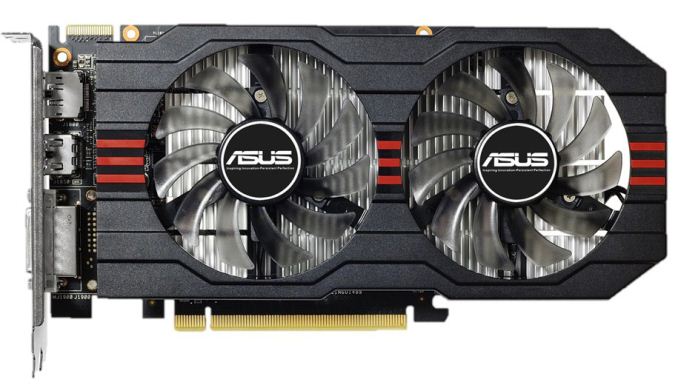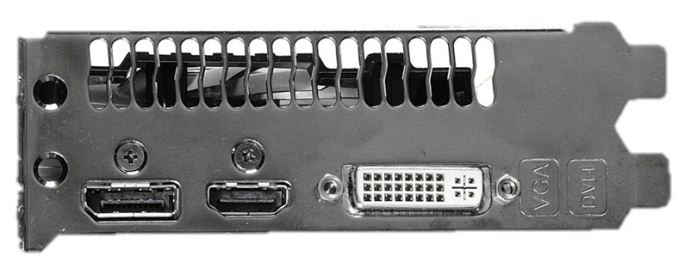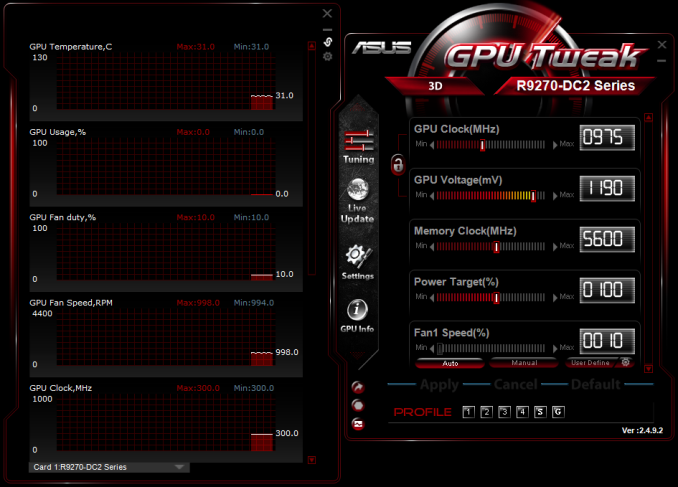The AMD Radeon R7 265 & R7 260 Review: Feat Sapphire & Asus
by Ryan Smith on February 13, 2014 8:00 AM ESTMeet The Asus Radeon R7 260
Our other card of the day is our R7 260 sample from AMD, which comes in the form of a complete retail card: Asus’s Radeon R7 260. This is a standard retail card, featuring a solid design but no factory overclock or other frills.
Surprisingly for a 95W card, Asus’s card is a dual fan open air design. Based on a variation of their dual fan coolers, Asus utilizes a relatively simple aluminum heatsink directly mounted to the Bonaire GPU beneath. This heatsink has a large base that serves to cover the RAM, but not the VRMs towards the front of the card, and mushrooms out at the top to form a larger surface for the dual fans to cool. Truth be told we were pleasantly surprised by this design; these larger dual fan designs are uncommon for sub-100W cards, and even with the relatively simple heatsink it’s essentially oversized for the GPU in question, though as we’ll see in our noise results this is clearly to the benefit of the user.
As a result of using such a large cooler on such a small board, the Asus R7 260’s cooler significantly overhangs the PCB. The PCB itself is just 6.8” long, while the cooler extends a further 1.9” to give the card a total length of 8.7”. As is usual for Asus, the card feature’s Asus’s Super Alloy Power discrete electrical components for enhanced durability. Meanwhile the fact that this is closer to a card strapped to a cooler than a cooler strapped to a card doesn’t do Asus any favors, especially since the GPU is towards the rear of the card. The short length of the card ensures it’s rigid enough, but there’s some opportunity for flexing towards the front of the card.
For Asus’s power connectivity, the single 6-pin PCIe power socket is found at the end of the card, orientated parallel to the PCB despite the significant overhang of the cooler. To make up for this, Asus has once again reversed the PCIe power socket so that the tab on the plug faces inwards instead of outwards, which makes this design practical as the cooler no longer blocks the tab.
As for Asus’s display I/O, Asus is using a simpler port layout that occupies just a single slot, presumably so that this PCB is capable of being used on single-slot designs if necessary. This results in the card having 1x DL-DVI, 1x HDMI, and happily enough for such a low-end card, 1x DisplayPort, as opposed to a VGA port. This gives the Asus card the ability to drive three digital displays at once for Eyefinity, or even a single 4K display if we’re talking about simple desktop work.
Meanwhile on the software side of things the R7 260 comes with Asus’s standard GPUTweak software utility. GPUTweak is a very competent overclocking suite that offers all of the overclocking and monitoring functionality we’ve come to expect from a good overclocking utility, including a wide array of monitoring options and support for GPU voltage control. Asus’s taste in skins is unfortunate – a low contrast red on black – but otherwise the UI itself is similarly solid. To that end GPU Tweak won’t match Afterburner on some of its more fringe features such as recording and overlays, but as a pure overclocking utility it stands up rather nicely.
Wrapping things up, as one of the only two R7 260 graphics cards currently Asus is both enjoying and being disrupted by the lack of sensible pricing among R7 260 cards. At a current retail price of $139 the Asus R7 260 is a full $30 (28%) over what should be a $109 MSRP for an R7 260 card, and $15 more expensive than the alternative MSI card. More importantly, it’s currently just as expensive as the more powerful R7 260X, which puts this card in an unfortunate spot since you can easily buy a more powerful card for less. Asus can enjoy a small premium from a good design and their 3 year warranty, but this is an especially treacherous position if R7 260X prices quickly come down to $119.
Finally, on a quick technical note we do want to point out that we have encountered one minor oddity with the Asus R7 260 that as of this writing is still being looked into by AMD. The card we received has its GPU idle clockspeed at 550MHz, instead of the 300MHz clockspeed that is common for all other AMD GCN cards, including their other Bonaire cards. The ramifications of this are minimal as it doesn’t affect the load performance of the card in any way, but it does mean the card is technically running at a higher clockspeed than it should at idle, which can affect idle power consumption. We’re seeing 74W at the wall, the same as our reference R7 260X, but our GPU testbed is admittedly not well suited to picking up small fluctuations in idle power consumption like this on such a low powered card. In any case we don’t believe it to be a dealbreaker, but AMD is currently looking into it to try to determine what’s going on.














52 Comments
View All Comments
AlucardX - Thursday, February 13, 2014 - link
Since the 7850 was a great overclocker, I wonder how this rebadge product is. Any plans to overclocking with an increased Vcore?Ryan Smith - Thursday, February 13, 2014 - link
Not with this one. I only had 2 days to put this review together, so unfortunately there wasn't time for overclocking.krumme - Thursday, February 13, 2014 - link
Intel Core i7-4960X at 4.2GHz with a 260 playing BF4 single player.Perhaps not the most realistic scenario in this world.
MrSpadge - Thursday, February 13, 2014 - link
It shows you what the card can do. If you're concerned about your CPU limiting you in BF4 multi player.. well, better read a CPU review.krumme - Friday, February 14, 2014 - link
A user playing with the s260 will typically have dual core i3. Thats reality. Try that with or without mantle in Multiplayer 64 man on the big maps. It the difference between playable or not playable. Probably more than 50% difference in favor of mantle. Instaed we get this useless talk.Rebel1080 - Friday, February 14, 2014 - link
What you're getting here is the equivalent of an Xbox One for $119 or PS4 for $149. It took Nvidia and ATI about 12-18 months just to release a video card of equal or better performance for under $199 after the seventh generation's (Xbox 360/PS3) debut. The fact that it only took 3 months to get to this level for under $150 during this generation only shows just how much $ony and M$FT low balled it's customers on specs.silverblue - Friday, February 14, 2014 - link
Except you then have to factor in the rest of the hardware to that price. Think about it - CPU, cooling, motherboard, memory (I don't think 8GB of GDDR5 is cheap), storage, case, power supply, software and the all-important input devices. Add in the fact that developers will get more out of the console GPUs than with the PC and I think you're ragging on them a bit too much.Antronman - Wednesday, February 19, 2014 - link
You mean 4GBs of DDR3. And likely high CAS latency too. Low-watt GPUs. Software only costs how much you pay the employees. Input ports are part of the mobo. DEVs do not get more out of the console GPUs. They are actually underclocked so that you don't need desktop-grade cooling. Consoles will never be serious gaming machines. People who buy consoles either won't spend the money on a good PC, can't spend the money, or would rather spend the money on dozens of games that they'll only play a couple of hours of and then just stick to one game.golemite - Saturday, February 15, 2014 - link
270's inflated prices are directly the result of cryptocoin mining as it has been found to offer an advantageous Kilo-hash to Watt ratio. It would be interesting and helpful to many out there if Anandtech started publishing KH/sec and KH/watt metrics in its review for Scrypt mining.Will Robinson - Monday, February 17, 2014 - link
Nice addition to the AMD lineup.... and a pretty convincing demolition of NVDA's competing cards.Thanx for the review!